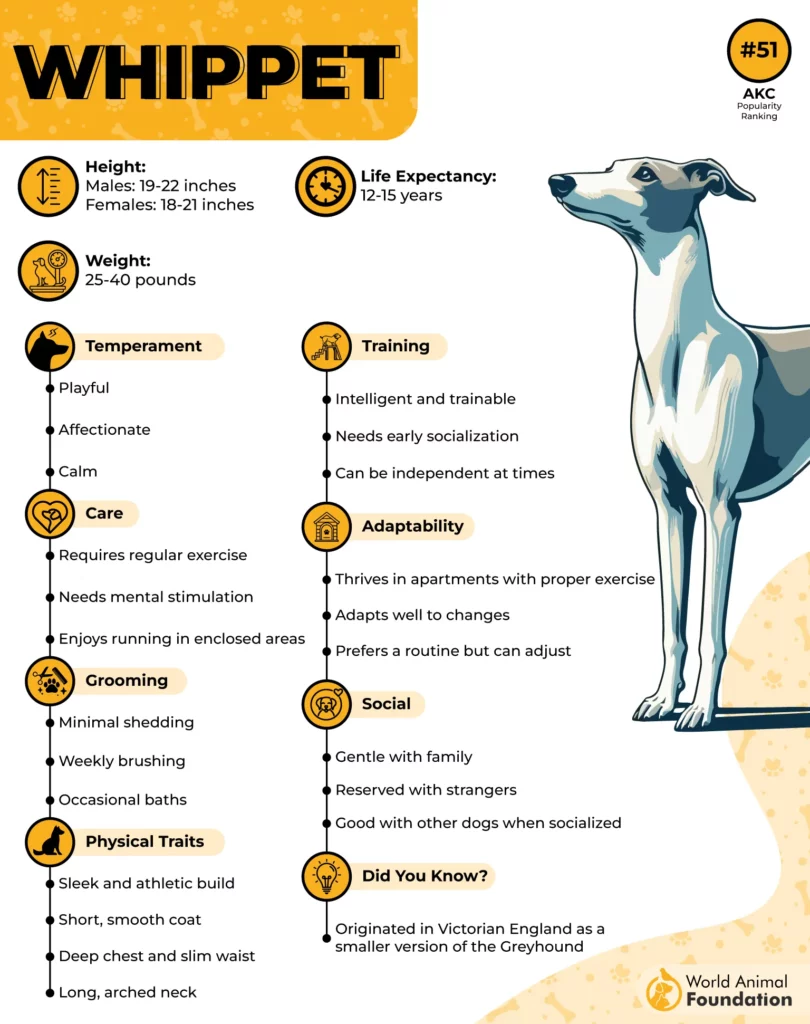If you’ve ever mistaken a Whippet for a Greyhound, you’re not alone. These sleek, graceful, and affectionate breeds share striking similarities—but their differences might surprise you. While both are known for their elegance and athleticism, they each have unique traits that make them suited for different lifestyles.
Whether you’re looking for a calm cuddle buddy or an active companion, choosing between a Greyhound and a Whippet requires understanding their temperament, history, health, and care needs.
In this guide, we’ll break down everything you need to know—so you can find the perfect furry friend for your home. Let’s dive into the ultimate Greyhound vs. Whippet showdown!
Greyhound vs. Whippet
Greyhound vs. Whippet: History
The Greyhound is one of the oldest dog breeds, dating back over 4,000 years to ancient Egypt. Pharaohs treasured these sleek, fast dogs for their hunting skills and loyalty. Over time, Greyhounds became favorites among European nobility, known for their speed and grace. Eventually, they made their way into professional racing, where their incredible agility and endurance earned them worldwide recognition.

On the other hand, the Whippet has humbler beginnings. Often called the “poor man’s racehorse,” this breed emerged in 19th-century England, where coal miners bred smaller Greyhound-like dogs for racing and rabbit hunting. Their compact size and lightning-fast speed made them ideal for competitive sprinting, but they were also beloved for their gentle and affectionate nature—traits that made them fantastic calm dogs for families.

Though closely related, their histories shaped them differently. The Greyhound remains a great dog for those who appreciate its laid-back yet athletic nature, while the Whippet’s past as a working-class racer makes it adaptable, playful, and perfect for people who want a smaller yet equally swift companion. While both the Whippet and the Greyhound share elegance and speed, their unique journeys make them stand out among other dogs.
Greyhound vs. Whippet: Speed
When it comes to sheer velocity, the Greyhound holds the crown as the fastest breed, capable of hitting a top speed of 45 mph as mentioned in Britannica. Built like a high-energy dog, Greyhounds have long legs, deep chests, and powerful muscles that allow them to reach speeds unmatched by most canines. Originally bred for hunting and racing, they can sprint effortlessly, but surprisingly, they’re total couch potatoes once indoors.

The Whippet, on the other hand, is often seen as the Greyhound’s smaller twin, but don’t underestimate it. While not as fast—typically reaching around 35 mph—it’s exceptionally agile and built for short bursts of speed, as stated in AKC. This makes Whippets ideal for agility sports, quick chases, and games of fetch. Unlike Greyhounds, they often have more exercise demands and thrive on activities that challenge their reflexes and endurance.
When comparing Whippet vs. Greyhound, their exercise needs differ. If you want a laid-back sprinter who’s content with occasional runs, a Greyhound might be the right fit. But if you’re after a playful, active pup that enjoys interactive sports and chasing small animals, a Whippet is the better choice.
Greyhound vs. Whippet: Temperament
If you’re looking for a laid-back, affectionate dog, both the Greyhound and the Whippet fit the bill—but their personalities have some key differences. The Greyhound is known for its gentle and independent nature, often content to lounge around for hours. Despite their history in lure coursing, they are surprisingly low-energy indoors, making them ideal for calm households or individuals who prefer a relaxed companion.
The Whippet, however, is the more playful of the two breeds. While they share the Greyhound’s love for napping, they tend to be a bit more energetic and eager to engage in dog sports like agility and fetch. Whippets also thrive on human interaction, making them a great choice for families with older kids who want a fun yet affectionate pet.

When it comes to living arrangements, both breeds can do well in apartment living, as long as they get regular exercise. That said, Whippets, being a smaller dog, might adjust even better to compact spaces. They also tend to be more adaptable to households with other pets. Whereas Greyhounds—due to their racing background—might have a higher prey drive.

Ultimately, if you want a quiet, independent companion, a Greyhound is a great choice, while a Whippet is the better fit for those seeking a lively, affectionate, and social pup.
Greyhound vs. Whippet: Colour
When it comes to coat colors, both the Greyhound and the Whippet offer a stunning variety. Greyhounds come in almost every color imaginable—solid shades like black, fawn, and blue, as well as beautiful brindle and parti-color patterns, as stated in WebMD. Whippets, on the other hand, have a similar range but often display more distinct markings and softer color blends, giving them a slightly different look despite their close relation.

Since both breeds have short coats, grooming is refreshingly low-maintenance. A quick weekly brush and occasional bath are all they need to keep their fur sleek and healthy. Shedding is minimal, which makes sense for breeds built for speed rather than fluff. However, their thin coats also mean they are sensitive to cold weather, so owners should invest in doggy sweaters for chilly days.
While coat color might be one of the main differences you’ll notice at first glance, it’s not the most important thing when choosing between these two breeds. There are many traits, like temperament and energy levels, that play a much bigger role in finding the right fit for your lifestyle.
Greyhound vs. Whippet: Health
Both Greyhounds and Whippets are generally healthy breeds, but like all dogs, they have certain health problems to watch out for. Greyhounds, being larger, are prone to hip dysplasia, bloat, and even bone cancer in their later years. Their thin skin also makes them more susceptible to cuts and scrapes, which means extra care is needed during outdoor play.

Whippets, being a miniature Greyhound in many ways, share some of these concerns but have their own unique risks. Heart conditions, such as mitral valve disease, are more common in Whippets, and their lifespan can be affected if not monitored closely. Eye issues, including progressive retinal atrophy, can also develop as they age. Since both breeds have low body fat, they are extra sensitive to anesthesia, making vet procedures something to approach with caution.
With proper care, Greyhounds typically have an average lifespan of 10–14 years, while Whippets can live slightly longer, often reaching 12–15 years. To ensure a good life expectancy, regular vet checkups, a balanced diet, and safe exercise in open spaces are essential. Keeping them at a healthy weight and providing joint support as they age will go a long way in keeping them happy and active for years to come!
Conclusion
If you’re torn between a Greyhound or a Whippet, ask yourself: Do you want a couch potato sprinter or a playful speedster? Both thrive with daily exercise—a quick zoom around the dog park or a safe fenced yard is perfect!
They’re smart but sensitive, so positive reinforcement is key for teaching basic commands. Be mindful of separation anxiety; they love their humans dearly! The American Kennel Club recognizes many breeds, but these two stand out for their elegance and speed. No matter which you choose, get ready for a fast, lovable, and devoted best friend.


